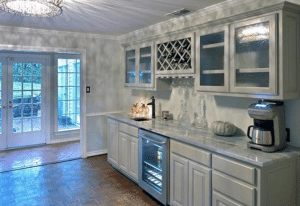
Natural stone has long been valued for its beauty, durability, and timeless appeal. From ancient structures to modern homes, these materials have stood the test of time, offering a range of aesthetics and practical benefits. If you’re considering adding natural stone to your home, it’s important to understand the different types available and what each brings to the table. Whether for countertops, flooring, or exterior surfaces, selecting the right stone can elevate your space in both function and design. Below, we’ll take a closer look at some of the most popular types of natural stone used in homes, giving you the information you need to make the right choice for your next project.
Granite: The Go-To for Durability and Beauty
Granite is one of the most widely used natural stones in home construction, and for good reason. Known for its incredible hardness, granite is perfect for countertops, flooring, and even exterior applications. It’s made from quartz, mica, and feldspar, creating a tough material that resists scratches, heat, and stains. Granite’s durability makes it ideal for high-traffic areas like kitchens, where countertops are exposed to heavy use.
Granite’s beauty comes from its natural patterning and rich colors. You can find it in a range of shades, from dark blacks and browns to vibrant reds, greens, and blues. These variations come from the different minerals within the stone, meaning no two granite slabs are exactly alike. This uniqueness adds a custom touch to your home that’s hard to replicate with synthetic materials.
Granite’s toughness doesn’t mean it’s invincible, though. Like any natural stone, it requires regular sealing to keep it looking pristine and to prevent moisture or bacteria from penetrating its porous surface. However, with minimal care, granite countertops or floors can last a lifetime.
Quartzite: The Hardest Natural Stone for Countertops
Often confused with quartz (which is an engineered product), quartzite is a natural stone known for its extreme hardness. It’s even more durable than granite, making it an excellent choice for countertops, especially in busy kitchens where wear and tear are constant. Quartzite’s stunning appearance resembles marble, offering a more luxurious look while still providing superior durability.
What sets quartzite apart is its shimmering, crystalline sparkle, which gives it a unique depth and beauty. It comes in various colors, from white and gray to pink and green, and many of its slabs feature striking veining, similar to marble.
The one thing to note about quartzite is that, while it’s harder than granite, it still requires sealing to protect it from stains. However, its low-maintenance needs and resistance to heat make it a top choice for homeowners looking for a long-lasting, beautiful countertop material.
Marble: Luxury and Elegance for High-End Homes
When people think of luxury in the home, marble often comes to mind. It has been used for centuries in palaces, monuments, and upscale homes. The stone’s soft, elegant veining and smooth finish make it perfect for those seeking a timeless, sophisticated look.
Marble is most commonly used for countertops, backsplashes, and flooring in bathrooms, though it can be used in kitchens as well. The biggest drawback of marble is that it’s softer and more porous than granite and quartzite, making it more prone to scratching and staining. This means it requires more care and regular sealing to maintain its beauty.
Despite these challenges, many homeowners believe the beauty of marble is worth the extra maintenance. If you’re after a clean, polished look with a bit of old-world charm, marble is an excellent option. Just be prepared to baby it a little to keep it looking pristine.
Limestone: A Versatile Stone with a Natural Look
Limestone offers a softer, more natural look compared to granite or quartzite. It’s often used in both interior and exterior applications because it weathers beautifully, developing a unique patina over time. Limestone is commonly seen in flooring, walls, and fireplaces, but it’s also popular for outdoor applications like patios and garden walls.
One of the key benefits of limestone is its ability to be shaped and cut easily, making it versatile for custom projects. However, because it’s more porous than other stones, limestone isn’t usually recommended for kitchen countertops, where it can be easily stained by oils and acids.
That said, limestone’s ability to give a natural, earthy appearance to a home’s exterior or interior makes it a popular choice for homeowners who want a relaxed, organic aesthetic. Keep in mind that it will need regular sealing and cleaning to prevent damage and maintain its look.
Travertine: A Stone Formed by Nature’s Forces
Travertine is a type of limestone formed by mineral deposits from natural springs. It’s known for its small cavities and pitted texture, which give it a distinctive appearance. Travertine is often used in bathroom flooring, shower tiles, and even countertops due to its soft, neutral tones and unique texture.
One of the reasons travertine is so popular is its ability to develop a natural, rustic look that fits well with Mediterranean or classic design styles. It comes in shades of cream, beige, gold, and even rust, offering a range of options for those looking to create a warm, inviting space.
While it’s beautiful, travertine is also porous, so it requires sealing to prevent moisture damage and staining. However, if you’re willing to put in the effort for upkeep, travertine can be a stunning addition to any home.
Sandstone: A Natural Fit for Outdoor Spaces
Sandstone is another soft, sedimentary stone, but it offers a completely different look compared to other natural stones. Its earthy, warm tones make it a popular choice for outdoor projects like patios, pathways, and pool surrounds. Sandstone is known for its ability to change color depending on the lighting and time of day, giving it a dynamic, ever-changing appearance.
One of the benefits of sandstone is that it’s relatively easy to work with. It can be cut and shaped into a variety of sizes and shapes, making it versatile for custom projects. While it’s durable for outdoor use, it can be more prone to weathering and erosion, so it may need more frequent sealing compared to harder stones like granite or quartzite.
Flint: A Unique Option for Rustic Designs
Although flint isn’t as commonly used in the United States, it has a long history of being utilized in England for building churches, farmhouses, and more. This stone is prized for its durability and unique appearance. Flint comes in a range of colors, including gray, black, and even red, offering a one-of-a-kind look for your home.
If you’re going for a rustic or old-world design, flint can add authenticity and charm. While it’s not as well-known or widely used as other natural stones, flint’s durability and beauty make it an interesting choice for those looking to add a touch of European flair to their home.
Choosing the Right Natural Stone for Your Home
With so many types of natural stone available, selecting the best one for your home can be overwhelming. The key is to balance aesthetics with practicality. Consider how much maintenance you’re willing to invest, the level of durability you need, and the design style you’re aiming for.
Whether you’re drawn to the luxury of marble, the toughness of granite, or the natural beauty of limestone, natural stone has the power to transform any space into something truly special.
Need help finding the perfect natural stone for your project? Contact Wholesale Granite Direct at 817-962-2616 in Arlington, TX, or 817-710-8604 in Granbury, TX. Our team is here to guide you through your selection process, ensuring you get the stone that best fits your home’s needs.

